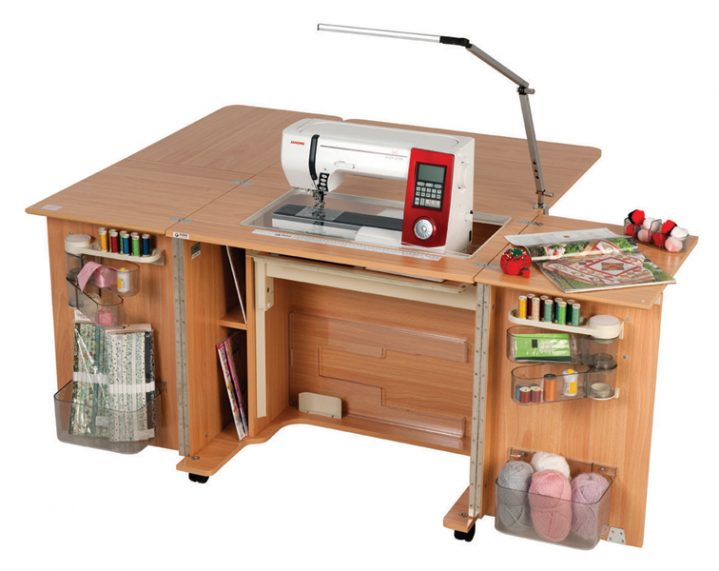
Know Your Product: Sewing Furnitures
Many of us don’t have the appropriate storage for all of our sewing accessories, nor — and even more importantly — a dedicated workspace for sewing.
Do you sew at the kitchen or dining table, setting up and packing down around family meals? Not only is it frustrating, it can be unmotivating! But if you don’t have the space for a dedicated sewing room, what are your options? Sure, you can wait (patiently) for the adult children to leave home and seconder their bedroom, or you can make the best of the situation with the purchase of purpose-built sewing furniture that can be set up in a dedicated space in a small area, opened out to use and easily closed down when not in use.
Sewing tables and cabinets come in a variety of shapes and sizes, with drawers and compartments to store fabrics, scissors, sewing patterns, trims, pins and other equipment, as well as a flat surface to place a sewing machine, or better still, a lifter mechanism that will allow you to drop the sewing machine to two or three heights, depending on your need: stored, flat-bed sewing, free-arm sewing.
The classic sewing cabinet was a smaller whole unit that primarily catered to your sewing and stitching needs. It was designed as a dedicated workspace where supplies and notions can be organised. The purpose of the three levels of airlift is so the sewing machine can be lowered right down, and the lid closed and locked when not in use.
Over the years these cabinets have grown to accommodate larger areas behind the machine for quilting and more space to either side for cutting, or to set up your overlocker so it can be dropped down and closed when not being used.
These closable, lockable cabinets can, by their very nature, only go to a certain size, so if you require larger areas, or you are fortunate enough to have a dedicated sewing room, you may like to consider modular systems.
If you do have your own sewing space (what bliss!), the good news is that modular furniture can provide all types of configurations. You can start off with a few key pieces and add to them as other needs become more apparent (or your stash and number of machines increases!).
So, that said, whether you are buying the classic style for limited space or portability reasons, or modular pieces that can be added to fit a larger space, there are some considerations to take into account. Whichever you choose, ensure the furniture suits your personal ergonomic needs and allows you to work within the space in the manner that suits you.
Portability
If you want to wheel it from one room to another, fold it down and store it away when not in use, then foldable tables, with sturdy wheels, are a great option. If you purchase one that is also height adjustable, you can easily, and ergonomically, use it as a cutting area too. Many of these tables have a lift system for your machine — and cut-outs are available for almost all machine makes and models these days.
Space
If space is a consideration, look at foldaway tables and closable and lockable cabinets that can be placed in a permanent space but can be folded down to a smaller size when not in use.
Surface Area
Do you require extra space behind the sewing machine when piecing or quilting? Classic cabinets and modular systems offer both extra space in differing sizes. It is more convenient if you can undertake all of your sewing processes in the one location. Some sewing tables have a gridded surface and a tape measure along the edge.
Storage Space
The smaller your sewing furniture, the less storage space you will have. Check that the item you are considering has the right amount of storage for your needs. Do you need to fit an overlocker into it? Or do have a large collection of threads and notions you need to have at hand?
Airlift, or Lifter
An airlift mechanism provides you with the option to have your sewing machine at various heights without any struggle. It is a very user-friendly feature that means you do not need to be lifting your machine up and down, or in and out of its storage place.
Other Thoughts
- Will you be able to assemble it? Some brands offer to assemble for an additional cost.
- Is it sturdy? Try sewing fast on it — does it stay still?
- Do the wheels move freely? Can you move it if you need to?
- Is the height of the sewing surface correct for you? If it isn’t, you will suffer with unnecessary back, neck and arm pain.
- Can you easily move between the areas? Do you knock your knees or is there not enough space for your legs?
- Is it easy to open and close?
- Does it fit your machine? Perspex inserts are available for almost every make and model; make sure one is available to fit your machine.
Janome Universal Sewing Table with Insert
This flat-bed workspace includes a custom insert that meets the edges of your machine, providing for a broader, smooth surface area. It is suitable for piecing, quilting, dressmaking and other crafts that require a larger expanse.
Classic Cabinets
Each of the classic-style Horn sewing cabinets offers a usable, portable and stowable option and, when not in use, can be closed and locked.
The Nullarbor closes to a size of 1100mm (43 1/4in) W, 515mm (20in) D and 760mm (30in) H. It includes a Perspex insert, an accessory tray with a clear cover to the right of the machine, and an extended surface to the left. There are swivel trays in the left door and a storage area, and on the right there is space for an overlocker and a deep drawer. It also includes a three-position lifter for your machine.
Or take it up a notch with the Kensington MK11, which offers an open depth of 1675mm (66in) as opposed to the Nullarbor’s 1030mm (401/2in) depth, and it offers a different configuration with the doors, storage and surface work area.
There are four different classic Horn cabinets to compare to find the right size and functionality for your needs.
Sewing Cutting Table
This Horn height-adjustable table includes a manual lifter (turned by handle) to allow you to position the machine to the height you need, including ‘flat bed’, which can achieved with the purchase of a Perspex insert.
The castors are sturdy and lockable and there is space for a cutting mat, allowing you to cut at the correct height to reduce back, neck and shoulder strain when cutting. The working area is 1600mm (63in) W by 900mm (35 1/2in) deep. The table top tilts by 90 degrees for easy storage.
Modular Sewing Cabinets
Start with the basic sewing cabinet that offers the maximum-size lifter and bifold doors that slide into the cabinet. There are adjustable shelves to the left. The wheels have lockable castors and the cut-out area has grooved recesses for flat-bed sewing. The machine can be positioned as far forward as possible. When the cabinet is closed, it measures 975mm (38 1/2in) W, 600mm (24in) D and 750mm (30in) H.
A back extension kit is available to increase the depth by 400mm (16in).
Other Modular Configurations
Horn offers a variety of add-ons, including thread drawers, shelves, deep drawers, shallow drawers, ironing pads, space for cutting mats and more.
Corner Sewing Cabinet
This is an excellent option to make use of the corner of the room. It features a swivel-style lifter and works well for a sewing machine or a computer table. The wheels are lockable. A back extension is not possible for the cabinet.








